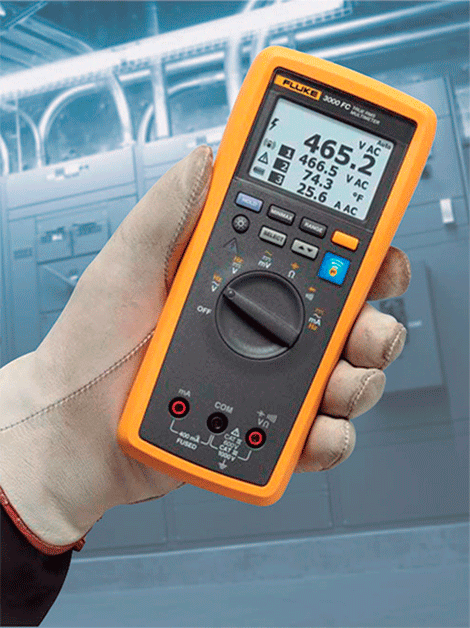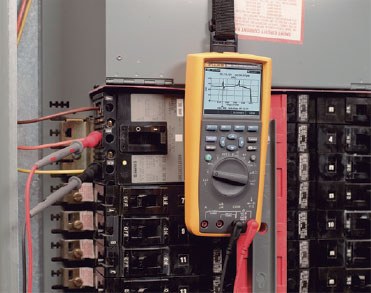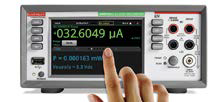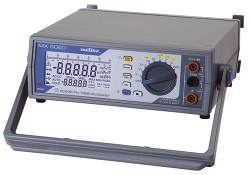Un multimeter Digital is an electronic measurement tool widely used in electronics and electricity to measure various electrical properties with high precision, especially voltage (volts), current (amperes) and resistance (ohms). Unlike analog multimeters, which use a needle and scale to display measurements, digital multimeters display results on a digital screen, making them easier to read and offering greater measurement accuracy. Analog multimeters became obsolete.
A multimeter consists of the following parts:
- Screen or Display: Displays the numerical values of measurements in digits. This makes it easier to read the results accurately, since there is no need to interpret a needle on a scale as in analog multimeters.
- Buttons: They are used to select the different options depending on the multimeter model.
- Selector: Also called rotary switch, used to select measurement values (amps, ohms and volts).
- Tips: These are the multimeter inputs to which cables or probes are connected to measure different electrical properties. Digital multimeters usually have two main connectors: one black and one red.
How does a multimeter work?
A multimeter, whether digital or analog, works by measuring various electrical properties in a circuit or component. Here we explain how a digital multimeter works:
Start by connecting the test leads to the multimeter. Generally, there are two tips: one black and one red. The black lead connects to the common terminal (COM or NEG) of the multimeter, and the red lead connects to the specific terminal corresponding to the measurement function you want to perform (VΩmA to measure voltage, resistance and current, A to measure current, mA to measure small currents, etc.).
Next you will have to select the measurement function, for this turn the knob or use the multimeter buttons to select the measurement function you want to perform, such as measuring voltage, current, resistance, capacitance, frequency, continuity, diodes, etc. Make sure the chosen function is compatible with the measurement you want to make.
For range selection on most digital multimeters, you can choose the measurement range automatically or manually. In automatic mode, the multimeter automatically selects the appropriate range based on the magnitude of the measurement. In manual mode, you must select the range yourself, making sure it is wide enough to cover the expected value.
To make the connection to the circuit or component you will have to have the test leads connected and the appropriate function and measurement range selected, connect the test leads to the circuit or component you want to measure. To measure voltage, place one test lead at the reference point (ground) and the other at the point where you want to measure the voltage. To measure current, place the multimeter in series with the circuit (interrupting the flow of current) and to measure resistance, connect the test leads across the component or resistor.
The multimeter screen will show the measurement value in digital numbers. Read the value accurately. Some multimeters can also display polarity (positive or negative) in voltage measurements.
And lastly and no less important than this, we have the shutdown function, when you have finished using the multimeter, turn it off to conserve the battery. Some multimeters have an auto shut-off feature to save power.
It is important to follow safety practices when using a multimeter, especially when measuring dangerous voltages and currents. Also, be sure to understand and respect the measurement limits of your multimeter to avoid damage to the tool or incorrect results. Reading the values is done in a similar way on an analog multimeter, but instead of a digital display, you see a needle that indicates the value on a scale. We hope you liked the explanation of how a multimeter works.
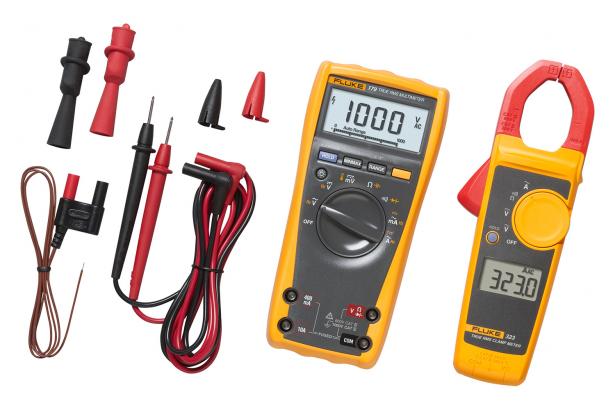
What is a multimeter for?
A multimeter is used to make precise measurements of various electrical parameters in circuits and components. Here is a description of the main functions and uses of a multimeter:
- Voltage Measurement (Strain): A multimeter is used to measure the electrical potential difference between two points in a circuit. This is essential to verify if a power supply is working properly, check the voltage on a battery, or determine if a component is receiving proper voltage.
- Current Measurement: It can measure the electrical current that flows through a circuit or component. This is useful for checking the current drawn by a device, measuring short circuit current, and evaluating the performance of a component based on the current passing through it.
- Resistance Measurement: A multimeter can measure the electrical resistance of components, such as resistors, cables, and connections. This is useful for identifying the value of an unknown resistance, checking the continuity of a wire or component, and diagnosing resistance problems in a circuit.
- Continuity Measurement: Using a continuity feature, the multimeter beeps or displays a low resistance value when there is a continuous electrical connection between two points in a circuit. This is useful for checking the integrity of a cable or connection.
- Diode and Transistor Test: Some multimeters have the ability to check the polarity and characteristics of diodes and transistors. This is useful to confirm if these components are working correctly.
- Capacitance Measurement: Some advanced multimeters can measure capacitance, which is useful for checking the charge storage capacity of a capacitor.
- Frequency Measurement: Some multimeters can measure the frequency of a signal, which is useful in electronics and communications applications.
- Temperature Measurement: Some multimeters include temperature probes that allow you to measure temperature in degrees Celsius or Fahrenheit.
We hope that with this summary it has become clear what a multimeter is for and the main measurements that can be made.
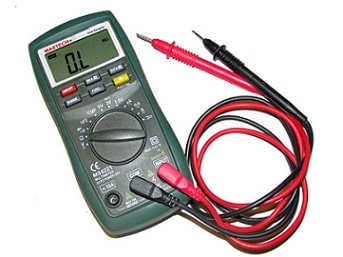
We hope you liked our article explaining everything we know about the multimeter, if you have any questions you can


